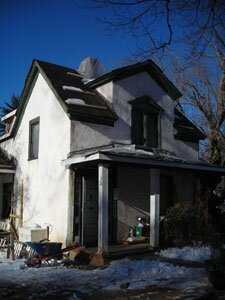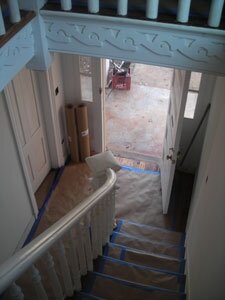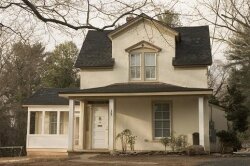Historically green: A guide to rehabilitation tax credits
What's the best way to go green if you have an older home? Salvage and/or rehabilitate it!
And if you ask most preservationists what they think of Virginia's Rehabilitation Tax Credit Program, you'll hear them proudly say it's one of the most generous programs in the country– if not the very most– leading to the rehabilitation of thousands of historic properties. Indeed, since the program's inception in 1997, the state has awarded nearly $700 million in tax credits to homeowners and developers.
Of course, like most things that sound too good to be true, it comes with a catch: you need to spend money to get money. And according to records obtained from the VDHR, only 12 property owners in Charlottesville and Albemarle County have taken advantage of the program since 2005.
Still, while the program tends to favor large rehabilitation projects (and therefore folks who can afford to spend a lot), small-scale projects can benefit, too. So saving and preserving what you already have not only saves the environment, but it also preserves history, and you can get free money for making the effort.
As long as you can spend more than 25 percent of your most recent assessment (just the house, not the land) on restoration work, you could get 25 percent state tax credit for “qualifying" expenses. Luckily, Virginia's program takes an expansive view. Practically all planning and construction costs constitute qualifying expenses. Furniture and window treatments, additions, and kitchen appliances are among the only things that don't count.
The old house doesn't even have to be on the Virginia Landmarks Register or contribute to a historic district to qualify. If a registered architect deems it “register eligible," it's in. An owner can even paint the old house any color she wants and sell the place– and still keep the tax credits. (Or sell them.)
So how do you apply?
First, you'll need to get some certification showing the building is historic. If its an individually protected property or already on the state or national historic register, you're all set. Again, getting an architect to confirm its "register eligible" also suffices. Next, you'll need to take photos of the property before you do any work.
Now comes the hard part. You'll need to describe each significant architectural feature of the home. You can do this yourself using the VDHR's Sample Rehabilitation Proposal as a guide, but you can also hire a consultant, a list of consultants can be provided by the VDHR.
When the work is done, you'll need to have the VDHR certify that it meets its standards. Photos of the work are also required. If eligible expenses are more than $100,000, you'll need to have a CPA certify those expenses.
Doing your part to save history
Rehabilitating your old house helps preserve history, and Charlottesville and Albemarle County need the help. The County's Historic Resources Department reports that over 50 significantly historic properties have been demolished since the mid-1970s, a trend that has picked up in recent years. According to photo-documentation from historic resources staff, since 2004, demolition of over 50 historic or potentially historic structures has occurred in the County– where policies to prevent it are virtually non-existent– and over 26 in the City.
In the City's Fifeville district alone, seventeen 100-plus-year-old properties have been demolished since 2006, including two in January of this year. Some notable losses include the Frank Ix building, the Terrace Theater, Belmont Hall, and the Charlottesville Lumber building on Avon Street.
In surrounding Albemarle County, notable losses include several turn-of-the-nineteenth-century houses in the Free State Community on Rio Road, one of the earliest free black communities in the state, and the place where Sally Hemings' sister Critta was supposed to have lived (the former Community is now the site of the Dunlora and Belvedere developments).
Lost, too, have been gems like a 1920s farmhouse near Gordonsville on Wildon Grove Road and the old Town & Country Motel on Pantops Mountain, an icon of popular roadside architecture and one of local architect Stanislaw Makielski's last designs.
Get help
There are plenty of resources in town to help you navigate the process. Preservation Piedmont helped with a modest rehab last year of an unusual circa 1870 Gothic Revival house on Hartman's Mill Road by surveying the historic property for the owners, guiding them through the application process, providing a grant for legal fees, and even helping them find a contractor willing to take on the historic renovation. In the end, the owners got a $25,000 tax credit and beautifully restored home for their daughter. You can contact Preservation Piedmont by visiting ppiedmont.squarespace.com/contact/
Of course, you can also check out the State program's website at dhr.virginia.gov/tax_credits/tax_credit.htm.
For that personal touch, however, don't hesitate to call or email Mary Joy Scala, Charlottesville's Preservation & Design Planner ( or 970-3182) , or her counterpart in Albemarle County, Margaret Maliszewski ( or 296-5832, ext.3276), who can both point you in the right direction.
~
This article stems from a longer piece on the topic, the Hook's June 2 cover story, "Extreme makeover: rich edition– State program benefits those who need it least."


